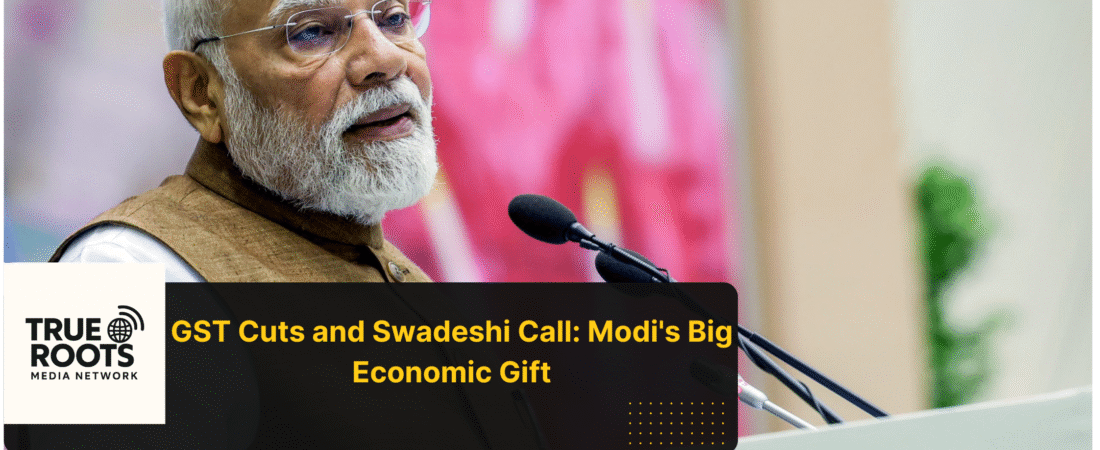Prime Minister Narendra Modi took to the airwaves today , September 21, 2025, to announce what he’s calling the “GST Bachat Utsav” – a savings festival that’s set to roll out from tomorrow, September 22, the first day of Navratri.
In a 19-minute address to the nation, Modi laid out the next wave of Goods and Services Tax reforms, promising lower prices on everyday items like medicines, hotel stays, and household essentials. He framed it as a “double bonanza” for families, especially the middle class, tying it to recent income tax exemptions for earnings up to Rs 12 lakh. But it’s not just about cheaper bills – Modi wove in a strong call for swadeshi, urging Indians to embrace homegrown products and build a self-reliant economy.
The reforms simplify the GST structure, scrapping the highest 28% slab for most goods and shifting them to lower rates like 5% or 18%. Modi highlighted how this will make 99% of daily-use items more affordable, putting extra money back in people’s pockets. Shopkeepers, he said, are already putting up signs comparing old and new prices, eager to pass on the savings. For small businesses and MSMEs, it’s a lifeline – easier compliance and lower costs mean more room to grow and hire. Modi stressed that these changes will speed up India’s growth, make doing business simpler, and draw in investors from around the world. He pointed out how GST, launched back in 2017, unified the country’s taxes, and now this update is the next big leap.
At the heart of Modi’s message was swadeshi – the idea of buying and selling Indian-made goods to fuel self-reliance. He drew a line from the freedom struggle, where swadeshi boycotts powered independence, to today’s push for Atmanirbhar Bharat. “Just as swadeshi strengthened our fight for freedom, it will now drive our prosperity,” Modi said, calling on every home and shop to become a symbol of local pride. He asked state governments to join in, promoting manufacturing and creating jobs through homegrown campaigns. For the festive season ahead, with Navratri starting, Modi suggested it’s the perfect time to choose Indian brands – from clothes to sweets – to support local makers and cut down on imports.
This comes amid global trade tensions, like the U.S. slapping tariffs on Indian exports, making Modi’s swadeshi pitch even more timely. He didn’t dive into those specifics but focused on how buying local builds strength at home. The reforms, he added, will make states equal partners in development, with simpler rules helping small towns and villages thrive alongside cities. Modi also touched on how MSMEs, the backbone of India’s economy, will benefit from reduced tax burdens and easier sales, urging them to aim for top-quality products that shine on the world stage.
Opposition voices aren’t fully on board. Congress leader Jairam Ramesh questioned if the cuts go far enough, calling them a “band-aid” and pushing for longer compensation to states. But Modi countered that the changes are a continuous process, evolving with India’s needs. For everyday folks, it’s welcome news – lower GST on travel and insurance means cheaper trips and peace of mind, while essentials like food and clothes get a price break just in time for festivals.
Modi’s address, timed perfectly before Navratri, blends economic relief with a patriotic nudge. Swadeshi isn’t new for him – it’s a recurring theme in speeches, from Independence Day to budget talks – but linking it to GST reforms gives it fresh energy. He painted a picture of households saving more, shops bustling with local goods, and India standing taller globally. For small business owners in places like Jammu or Delhi’s markets, this could mean more customers walking in with extra cash. Rural artisans, too, stand to gain if the swadeshi wave reaches their doorsteps.
The rollout starts tomorrow, so keep an eye on price tags – from your neighborhood kirana store to online carts. Modi ended with a call to action: make every purchase a vote for India. As Navratri brings garba and lights, this “savings festival” adds its own sparkle. It’s a reminder that policy can feel personal when it lightens the load. Whether you’re stocking up for the nine days or just trying to stretch the monthly budget, these changes could make a real difference. And with swadeshi in the mix, it’s not just about saving rupees – it’s about building a stronger, more self-confident nation, one local product at a time.
In the bigger picture, Modi’s vision ties into his long-term goals: a developed India by 2047, where every state pulls its weight and citizens feel the gains. The GST tweaks are part of that, simplifying a system that’s grown complex over years. Critics say it’s late, but supporters see it as smart timing, syncing with festive spending to maximize impact. Either way, as shops update shelves and families plan buys, the real test will be in the coming weeks – do prices drop as promised, and does swadeshi catch on beyond the speech?
For now, Modi’s words hang in the air like the scent of fresh garlands: a mix of hope, savings, and a gentle reminder to look local. Navratri starts with a bang – let’s see if our wallets feel the rhythm too.
#Modi #GST #TrueRootsMedia

